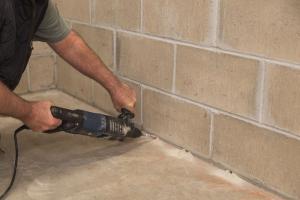Ultimate Guide: How to Effectively Waterproof Your Basement for Peace of Mind

-
Quick Links:
- Introduction
- Understanding Basement Leaks
- Importance of Waterproofing
- Signs of a Leaking Basement
- Waterproofing Methods
- Step-by-Step Waterproofing Guide
- Case Studies
- Expert Insights
- FAQs
Introduction
Waterproofing your basement is an essential home maintenance task that can save you from significant headaches and expenses. A wet basement can lead to mold growth, structural damage, and health issues. This comprehensive guide will dive deep into the methods, steps, and strategies you need to effectively waterproof your basement, ensuring a dry and safe environment for your home and family.
Understanding Basement Leaks
Basement leaks can occur due to various factors, including:
- Groundwater infiltration during heavy rains.
- Improper drainage systems.
- Cracks in the foundation walls.
- Clogged gutters and downspouts.
Understanding these causes is the first step in effectively waterproofing your basement.
Importance of Waterproofing
Waterproofing your basement is not just a matter of aesthetics; it's crucial for:
- Protecting your investment: A dry basement increases your home's value.
- Preventing health hazards: Damp conditions encourage mold growth and attract pests.
- Enhancing livable space: A waterproofed basement can be transformed into a usable area.
Signs of a Leaking Basement
Identifying the signs of a leaking basement early can prevent further damage. Look for:
- Water stains on walls or floors.
- Cracks in walls or floors.
- Musty odors.
- Peeling paint or wallpaper.
- Visible mold or mildew.
Waterproofing Methods
There are several waterproofing methods you can use, including:
Interior Waterproofing
This involves applying sealants to walls and floors and using dehumidifiers to control moisture levels.
Exterior Waterproofing
This method requires digging around the foundation and applying waterproof membranes or coatings.
Drainage Systems
Installing French drains or sump pumps can help redirect water away from your basement.
Step-by-Step Waterproofing Guide
Follow these steps to effectively waterproof your basement:
- Assess the Situation: Look for signs of moisture, cracks, and water stains.
- Choose the Right Method: Based on your assessment, select the appropriate waterproofing method.
- Prepare the Area: Clear out any furniture and debris from the basement.
- Repair Cracks: Use hydraulic cement to fill any cracks in the walls or floors.
- Apply Sealants: Use a high-quality waterproof sealant on the walls and floors.
- Install a Drainage System: Consider adding a French drain or sump pump if necessary.
- Monitor the Area: After waterproofing, keep an eye on the basement for any signs of moisture.
Case Studies
Let’s look at some real-world examples of successful basement waterproofing:
Case Study 1: The Smith Family
The Smiths faced chronic flooding in their basement during rainy seasons. After consulting a waterproofing expert, they installed a sump pump and a French drain, significantly reducing water ingress.
Case Study 2: The Johnsons’ DIY Approach
The Johnsons opted for a DIY solution by applying waterproof sealant and repairing cracks. They reported a noticeable improvement in humidity levels and no further water issues.
Expert Insights
Experts recommend regular maintenance checks on gutters and downspouts, along with timely repairs to cracks and leaks. Additionally, they emphasize the importance of proper landscaping to direct water away from the foundation.
FAQs
1. How often should I check my basement for leaks?
It’s advisable to inspect your basement at least twice a year, especially before and after the rainy season.
2. Can I waterproof my basement myself?
Yes, many homeowners successfully waterproof their basements using DIY methods. However, for severe issues, professional help may be necessary.
3. What is the cost of professional waterproofing?
The cost can vary greatly depending on the size of the basement and the methods used, typically ranging from $1,500 to $5,000.
4. How long does waterproofing last?
With proper installation, waterproofing can last for many years. Regular maintenance can extend its effectiveness.
5. Is it necessary to install a sump pump?
A sump pump is highly recommended for homes in areas prone to flooding or with a high water table.
6. What materials should I use for waterproofing?
Use high-quality waterproof sealants, hydraulic cement for cracks, and durable materials for drainage systems.
7. Can waterproofing help with mold prevention?
Yes, waterproofing significantly reduces moisture levels, thereby preventing mold growth.
8. What should I do if I find mold in my basement?
Remove the mold immediately using a mixture of water and detergent, and ensure the area is properly ventilated.
9. Can landscaping affect basement waterproofing?
Absolutely! Proper landscaping can help divert water away from your foundation, reducing the risk of leaks.
10. Are there any government programs for basement waterproofing?
Some local governments provide grants or low-interest loans for home improvements, including waterproofing. It's best to check with your local housing authority.
Random Reads
- Mastering bbcode upload images
- How to unlock a door without a key
- How to speed up slow windows computer free
- How to soundproof doors
- How to use prepackaged concrete mix
- Turn off low data mode
- Turn on vpn opera
- How to make computer operating system
- How to make degree symbol
- How to make a cake in minecraft